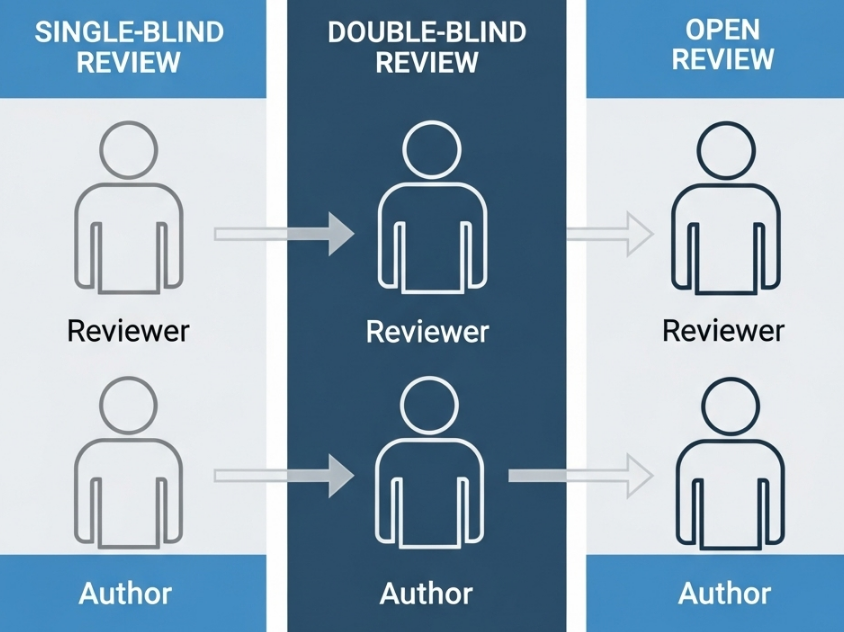

216 views||Release time: Sep 24, 2025
Peer review is the cornerstone of scholarly publishing, a critical process that validates research and upholds academic integrity. However, the way this review is conducted can significantly impact authors. The three predominant models—single-blind, double-blind, and open review—each present a different balance of anonymity, transparency, and potential for bias.

But for an author submitting their hard-earned research, which model is truly the fairest? The answer is complex, as each system has its own distinct advantages and disadvantages. This guide breaks down each model to help you understand the landscape of academic review.
In a single-blind review, the identities of the reviewers are concealed, but the author's name and affiliation are known to the reviewers.
How it works: The author does not know who is reviewing their paper. The reviewer, however, knows exactly who the author is, where they are from, and their career history.
Pros for the Author:
A well-established researcher from a prestigious institution may benefit from their reputation, potentially leading to a more favorable review (sometimes called the "halo effect").
Reviewers can check an author's previous work to see how the current manuscript builds upon it, providing a more holistic assessment.
Cons for the Author (and why it's often seen as unfair):
High Potential for Bias: This is the model's greatest weakness. Reviewers can (consciously or unconsciously) be biased against authors based on their gender, nationality, perceived junior status, or institution. This is particularly disadvantageous for early-career researchers or those from less famous universities.
Negative Bias: Conversely, a reviewer with a personal or professional rivalry with the author could use the cloak of anonymity to provide an unfairly harsh critique.
In a double-blind review, the identities of both the authors and the reviewers are concealed from each other.
How it works: The author submits an anonymized manuscript with no identifying information. The reviewers receive this anonymized version and provide their critique without knowing who the author is.
Pros for the Author:
Reduces Bias: This is the primary advantage and why it is considered the gold standard for fairness. It forces reviewers to judge the manuscript purely on its scientific merit, not on the author's reputation, affiliation, or background.
Levels the Playing Field: It gives early-career researchers and those from non-elite institutions the same opportunity as established "stars" in the field.
Cons for the Author:
Anonymization Can Be Difficult: In niche fields, it can sometimes be easy for a reviewer to guess the author's identity based on the research topic, self-citations, or writing style, potentially undermining the "blind."
Loss of Context: Reviewers cannot consider the author's previous body of work, which can sometimes be helpful for understanding the paper's contribution.
Open peer review is a newer and more radical model where the identities of both the authors and the reviewers are known to each other. Often, the review reports and author responses are published alongside the final paper.
How it works: Everyone knows who everyone is. The entire review process is transparent.
Pros for the Author:
Increased Accountability and Quality: Because reviewers must sign their names to their critiques, they are more likely to be professional, constructive, and thorough. It discourages lazy or overly harsh comments.
Constructive Dialogue: The process can become a more collaborative dialogue between the author and the reviewers, focused on improving the paper.
Reduces Potential for Unfairness: It is much harder for a reviewer to act on a personal bias or rivalry when their name is attached to their review.
Cons for the Author:
Reviewers May Be Less Candid: Some argue that reviewers might "soften" their criticism of a paper, especially if it is authored by a very senior or influential figure in the field, for fear of professional repercussions.
Difficulty Finding Reviewers: Some academics may be hesitant to participate in open review, making it harder for editors to find willing reviewers.
There is no perfect system, but here is the general consensus on fairness from the author's perspective:
For achieving impartiality and minimizing bias, the double-blind review process is widely considered the fairest model. It is designed to ensure that the quality of the science is the only factor under consideration.
For achieving transparency and accountability, the open peer review process is arguably the fairest. It holds reviewers accountable for their comments, which often leads to more thoughtful and constructive feedback for the author.
The single-blind review is increasingly seen as the least fair model due to the well-documented potential for conscious and unconscious bias to influence the review outcome.
Ultimately, the fairest system is one where an author's work is judged rigorously and constructively on its own merits. While not perfect, the double-blind model currently offers the best structure to achieve that goal, with the open review model presenting a compelling future based on transparency.